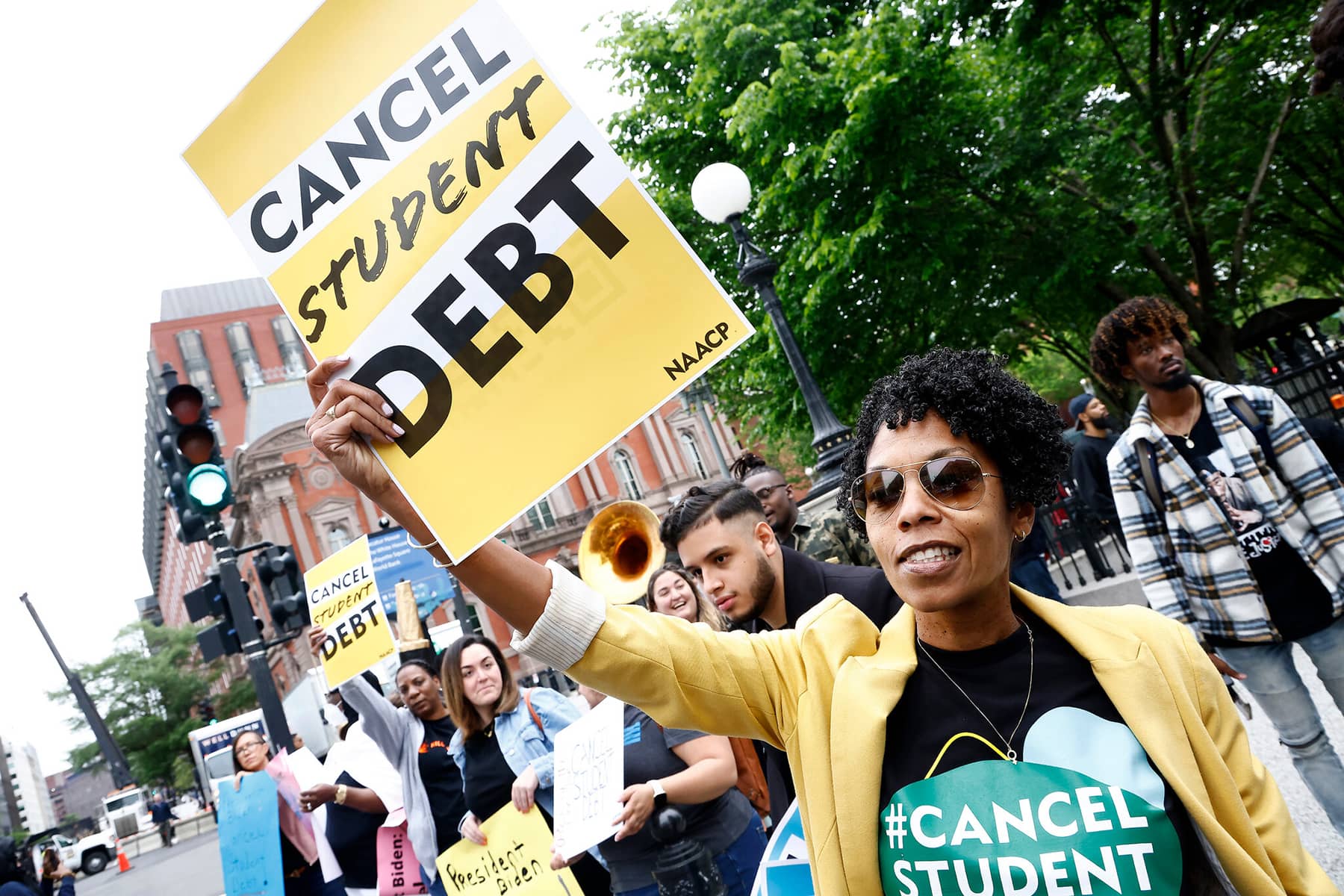
Conservatives love to talk about how expensive canceling student debt would be. In the words of the Committee for a Responsible Federal Budget, federal student debt cancellation, even when means-tested, is “regressive, inflationary, expensive and would likely do more to increase the cost of higher education going forward than to reduce it.”
Or as Forbes recently put it: “Canceling federal student loans will cost the federal government hundreds of billions of dollars – and it is the general public that will eventually end up footing the bill.” The author goes on to suggest that this “cost” imposed on taxpayers could threaten vital social programs like free and reduced lunch or any future hope of universal pre-K or guaranteed parental leave.
These conservative cliches have flooded editorials in leading news outlets in recent months. But if Joe Biden signed an executive order tomorrow, the government will not pay out a dime and those costs certainly do not have to be shouldered by everyday taxpayers at the expense of programs like Medicare or social security.
That is because federal student loan debt is already included in the national debt. The Department of Education (DoE) does not lend money to students directly. It borrows money from the U.S. Treasury, the federal department that prints money, and then lends that money to students.
As the Urban Institute points out, federal student loan debt is already accounted for in the national debt. This additional debt is added when the Treasury lends money to the DoE. Put another way, it was the creation of student loans that has added over a trillion dollars to the national debt.
The Urban Institute notes that while the national debt increases, the federal deficit decreases modestly as student loans are repaid. That is because when student loan borrowers pay back their debts, they pay interest on the loan. The interest that borrowers pay exceeds the Treasury’s interest rates. The DoE subtracts the difference and keeps the “profit” to pay for administrative costs and the servicing of those loans.
This system, for all practical purposes, has turned the DoE, which directly owns and manages about $1.5tn in student loans, into one of the largest banks in the US, behind Wells Fargo and Citigroup.
Because overseeing all these loans is an enormous administrative undertaking, the DoE pays third-party contractors like Nelnet – a publicly-traded company with an estimated net worth of more than $3bn – to help service these loans.
If federal student loans were canceled via executive order today, the government will not cut itself a trillion-dollar check to wipe away the debt on the national ledger.
Claims of student debt cancelation being “expensive” are misleading, perhaps intentionally so.
The “cost” conservatives speak of is actually lost revenue from the payments borrowers would be making on a monthly basis absent relief. These monthly payments have been suspended since 15 April 2020, and interest rates have been set to zero. Advocates of student debt relief have pointed to this executive action as a significant indication of Biden’s authority to cancel student debt without going through Congress.
As Slate pointed out, it may be easier to think about student debt payments as a “tax on households, putting a slight damper on consumer demand.” Households are shouldering this tax in the absence of public funding for higher education. This tax is marked up both by the Treasury and DoE’s interest rates and paid on a monthly basis over an average, by some estimations, of 21 years. This tax is not due all at once.
Biden, through an executive order, can pass a “tax cut,” or an extended student loan moratorium, by directing the DoE to stop collecting payments from borrowers indefinitely. These sweeping tax cuts have been done before.
In 2017, Donald Trump’s Tax Cuts and Jobs Act overhauled the tax code, permanently slashing the corporate tax rate by 40% and temporarily cutting taxes for individuals, both of which drastically cut government revenue.
The Congressional Budget Office estimated that these cuts would cost between $1tn to $2tn over a 10-year period – significantly more than would be due from student loans over the same period.
An analysis of Forbes data by Americans for Tax Fairness and the Institute for Policy Studies has determined that “American billionaires have grown $2.1tn richer during the pandemic,” which is equivalent to 60% of the 10-year cost of Biden’s $3.5tn Build Back Better plan.
Partiality by the U.S. toward abstract economic concepts like “deficit” and “inflation” ignores the reality of protracted human suffering and boils down to how economic health is measured.
Is it measured by the financial gains made by the 1% during a global pandemic that has left more than a million people dead? Or is it the number of families and working people who have successfully avoided eviction and poverty?
Will economic recovery in the wake of the pandemic be measured by the number of employees companies are able to hire at minimum wage or the number of Americans who feel as if they can move forward and build lives of their own with wages that cover their living expenses?
Trump argued that the tax cuts would pay for themselves by catalyzing substantial economic growth. That was never the case. Billionaires hoard. Working people spend.
The International Consortium of Investigative Journalists’ 2021 Pandora Papers, and their 2016 Panama Papers before that, document an elaborate “shadow financial system” that billionaires use at the public’s expense. ProPublica’s 2021 Secret IRS Files detailed how the “ultrarich effectively sidestep” the American tax system, with billionaires like Jeff Bezos, Elon Musk, Mike Bloomberg and George Soros getting away with paying no federal income tax in a given year.
If borrowers were given a tax cut in the form of student debt cancellation, this money would not be hoarded in offshore tax havens. It would go towards things like paying for living expenses, buying homes and starting families – vital indicators of a healthy economy in human terms.
A 2018 macroeconomic analysis of student debt cancellation from the Levy Economics Institute of Bard College estimated that student debt cancellation could boost real GDP by an average of $103bn to $130bn a year or $1.03tn to $1.3tn over 10 years (when adjusted for inflation in 2022).
In Levy’s analysis, the money the Treasury lends to the DoE does not disappear. Instead, “existing liabilities will be rolled over (that is, a new [Treasury] security is issued to pay for the maturing one) and the liabilities incurred when the loans were created simply become permanent.”
The national debt would be increased relative to the debt service the DoE owes to the Treasury over the life of the loan, not, as Levy points out, on the amount of the loans themselves.
In this equation, student debt cancellation is not so much a “cost” as a matter of accounting. It is a matter of adjusting revenues to what is deemed fair and of the most benefit to society. If we decided tomorrow that people’s lives are of greater value than corporate profits, there is no public bill to foot. If corporate tax rates were set at previous rates and billionaires paid their fair share, there would be no cost at all.
Student debt cancellation is not a solution to the student debt crisis. It is an acknowledgment that somewhere down the line something went seriously wrong. It is a clean slate for millions of Americans to move forward with their lives and seek a path toward social mobility, the cornerstone of the American dream that higher education once represented.
In the long run, the U.S. must move away from the byzantine system it now uses to fund higher education towards one where everyone who benefits from the value of an educated workforce contributes to the original investment.
In the meantime, conservatives have created mass hysteria around the national debt burdening future generations based on a myth that the federal budget should be treated like a household budget. The reality is that the portion of the national debt that is a real burden across multiple generations is a relatively small portion of the nation’s overall balance sheet and can be lifted from us tomorrow with one signature.
Іndіgо Оlіvіеr
Pаul Mоrіgі
Originally published on The Guardian as Conservatives claim canceling US student debt will be expensive. They’re wrong
Help deliver the independent journalism that the world needs, make a contribution of support to The Guardian.














